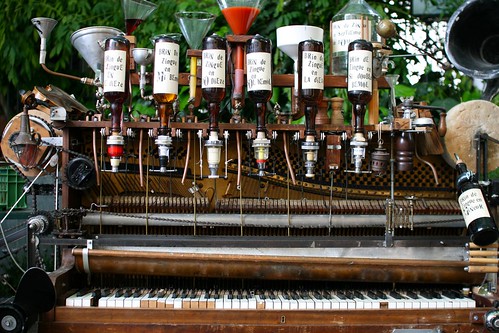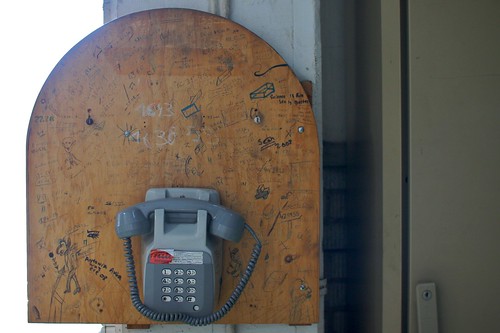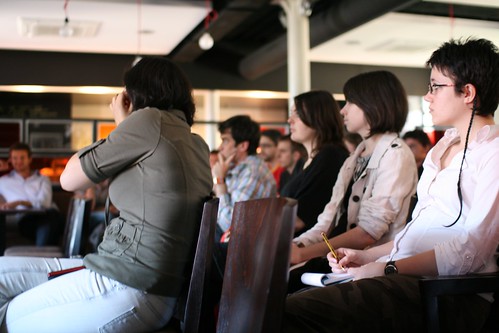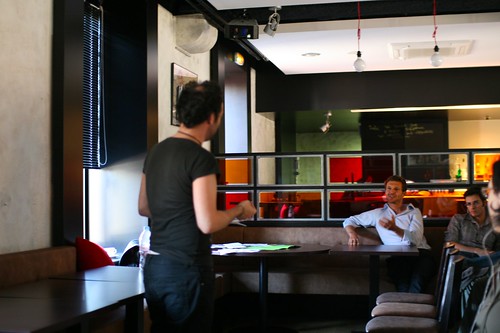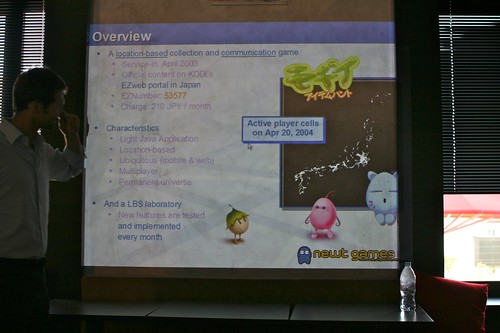Sony move and gestural interactions
 Some interesting insights about gestural interfaces, the Wii and Sony Move on Gamasutra in an interview of Rob Dyer (Sony Computer Entertainment America's senior vice president of publisher relations):
Some interesting insights about gestural interfaces, the Wii and Sony Move on Gamasutra in an interview of Rob Dyer (Sony Computer Entertainment America's senior vice president of publisher relations):
"There are certain games and certain genres that are great for motion gaming. I think the biggest problem that third parties have had with the Wii is that everybody had to implement everything with the Wii-mote, and a lot of games were never meant to have that kind of physical [interface]. It was supposed to be a D-pad only type of experience.
There are going to be some categories that are going to be absolutely spectacular with the Move. There are going to be some categories that are going to be very good with Natal. Now, the big difference with the Move and the Natal, if you're going to do it with Natal, you're going to do it exclusive with Microsoft. That's not going to be the case for the Move. You have a code base that works across all three platforms. How do you build that up and how you implement it into your game? Do I think you're going to see [inappropriate Move implementations]? Absolutely. Our challenge here is to make sure you're doing it with the right games and the right genres, and that's where we're spending a lot of our time, going back to people and going, "Good idea. Bad idea. Good idea. Yeah, not so good idea." Those are the types of things that we're trying to at least steer people away so they don't spend millions of dollars, come back to me and go, "Eh... It didn't sell." "Well, okay. You never should have made it. It was never going to work anyway. It didn't work on the Wii for a reason. That category didn't. Why did you think it was going to work on this one as well?" (...) The Wii doesn't have a camera. We've got a camera. Use that camera, implement that in there. A lot of these guys don't want to. They just want to use the accelerometer and say, well... No. Not gonna happen. It doesn't work that way. Put the camera in there, make it work with that, get your trophies, up-res is, put some more content in, come on down.
Why do I blog this? curiosity towards this new interface... and I cannot help framing it in the evolution of game interfaces. Surely some stuff for the game controller project
Habitar: bending the urbran frame
 For researchers and designers interested in urban informatics and architecture, the HABITAR exhibition at LABoral Centro de Arte y Creación Industria seems to be a great pick. The curator (José-Luis de Vicente) and his conceptual advisor (none other than Fabien) describe it as:
For researchers and designers interested in urban informatics and architecture, the HABITAR exhibition at LABoral Centro de Arte y Creación Industria seems to be a great pick. The curator (José-Luis de Vicente) and his conceptual advisor (none other than Fabien) describe it as:
"The new urban landscape is no longer predicated solely on architecture and urbanism. These disciplines now embrace emerging methodologies that bend the physical with new measures, representations and maps of urban dynamics such as traffic or mobile phone flows. Representations of usage patterns and mapping the life of the city amplify our collective awareness of the urban environment as a living organism. These soft and invisible architectures fashion sentient and reactive environments.
The Habitar project offers a journey through these emerging urban scenarios. It is a three-dimensional catalogue of projects and images by artists and design and architecture studios, as well as hybrid research centres and media labs. It is an overview of the practices, tools, solutions and languages that are being developed to negotiate every day life in this new urban predicament."
The artists, designers and researchers who contributed to this are: Timo Arnall, Julian Bleecker, Ángel Borrego - Office for Strategic Spaces, Nerea Calvillo, Citilab-Cornellà, Pedro Miguel Cruz, Dan Hill, IaaC - Instituto de Arquitectura Avanzada de Cataluña, kawamura-ganjavian + Maki Portilla Kawamura + Tanadori Yamaguchi, Aaron Koblin, Philippe Rahm architectes, Marina Rocarols, Enrique Soriano, Pep Tornabell, Theodore Mohillo, Semiconductor, SENSEable City Lab, Mark Shepard.
The catalogue of the exhibit (PDF) also features 8 essays from Benjamin Weil, Molly Wright Steenson, Bryan Boyer, Usman Haque, Anne Galloway, José Pérez de Lama and myself.
Why do I blog this? I see this exhibit (that i still have to explore) as an important landmark in the evolution of urban informatics. The projects and abstract considerations describes in the catalogue can be seen as interesting pointers to what I see as the most intriguing issues and topics in the field.
“I’ve never been sued by a door. But I guess I can live through it.”
 From Ubik, by Philip K. Dick (1969):
From Ubik, by Philip K. Dick (1969):
"The door refused to open. It said, “Five cents, please.” He searched his pockets. No more coins; nothing. “I’ll pay you tomorrow,” he told the door. Again he tried the knob. Again it remained locked tight. “What I pay you,” he informed it, “is in the nature of a gratuity; I don’t have to pay you.” “I think otherwise,” the door said. “Look in the purchase contract you signed when you bought this conapt.”
In his desk drawer he found the contract; since signing it he had found it necessary to refer to the document many times. Sure enough; payment to his door for opening and shutting constituted a mandatory fee. Not a tip. “You discover I’m right,” the door said. It sounded smug. From the drawer beside the sink Joe Chip got a stainless steel knife; with it he began systematically to unscrew the bolt assembly of his apt’s money-gulping door. “I’ll sue you,” the door said as the first screw fell out. Joe Chip said, “I’ve never been sued by a door. But I guess I can live through it.” "
Why do I blog this I really enjoy this quote and find it exemplifies the ever-increasing delegation of decisions that are embedded/inscribed into technical objects. The Ubik door might certainly be the ubicomp posterchild in a parallel (and dystopic) environment but it seems highly plausible nowadays. Let's accumulate this kind of examples and see what patterns one can find.
Context-aware applications in 2010
 Interestingly, location-based/Context-aware services are more and more present in the press. After the frenziness of 2004-2005 (and less interest afterwards), I see more and more article about the potential role of location and context as the starting point for complex scenarios. See for example the ideas described in this article:
Interestingly, location-based/Context-aware services are more and more present in the press. After the frenziness of 2004-2005 (and less interest afterwards), I see more and more article about the potential role of location and context as the starting point for complex scenarios. See for example the ideas described in this article:
- "My context device "knows" it's noon. It also knows (via accelerometer data) that I haven't moved from my desk for the last couple of hours. Because it "knows" I have a TBD lunch scheduled for 12:30 (it reads my tagged calendar entries), it will remind me I should leave. As soon as I move the device, it displays the list of places where I had lunch the last couple of weeks. Since most were Italian restaurants, it suggests Chinese or falafel and generates the latest consumer rating of the restaurants offered. At the same time, it also highlights restaurants located within walking distance that will allow me to be back in time for my scheduled 2 p.m. meeting.
- I am on a business trip to Madrid, have just finished my meetings and have three hours until my flight back to New York. My device "senses" I started moving and "knows" my schedule, therefore it asks me if I prefer to get a taxi to the airport, or if I prefer to stay in the city since the drive to the airport takes about 15 minutes. I choose the second option, slide the "ambient media streams" all the way from "privacy please" to "hit me with everything you've got," and the device offers me all the tourist attractions around me, even a nearby coffee shop that has received exceptionally high ratings (I love coffee). I choose the coffee shop, and as I am drinking my second cup, the device alerts me that my flight has been delayed by an hour and will board through gate E32. I drink another cup of coffee and read from my device the history of Madrid until the next alert updates me that I should call a taxi -- immediately providing me with an application that directly books one.
- I leave my office to interview someone at a nearby bar. My device "knows" it is a job interview (tagged in my calendar), therefore it automatically Googles the applicant, uploads his resume and image, and then provides me with a summary of the available information found about him from HR, the web and other social sources. As I approach the bar, my device turns itself into "meeting" mode, in which I can view a map that displays two dots approaching each other. As we meet, the device asks me if I would like to record the conversation and send it to HR."
Why do I blog this? I am not sure I am convinced by these scenarios but it's interesting to contrast them with the one we saw in 2004-2005. The move from location to context is interesting because it shows that the former is only a component of the latter. It also acknowledges the importance of taking into account the complexity of contextual information which cannot be limited to mere locational data.
Unlike the 3 stereotypical scenarios we had 5 years ago (friend-finding, location-based ads and geotagged post-its), the ones described here are a bit more complex and rely on the connection between "personalized social/behavioral data" and contextual information (location, time, etc.). Using algorithms, services would then be able to infer different things that can supposedly interest people, especially in urban environments.
Week-ending 105
[I started making weeknotes too, This is week 105 because I started working at Liftlab 105 weeks ago]
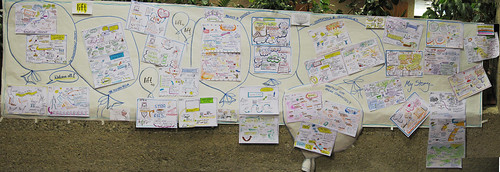
 Last week-end was a sort of retreat/holiday to recover from Lift10... and work on the "Lift insight" report, which will summarize the various topics that has been addressed at the Lift 10 conference two weeks ago. It was good have already existing material such as the drawings you see above (made by Integral Development) or the notes by Hubert Guillaud on InternetActu. The event was good and dense, as usual, and it's important to highlight what has been uncovered. I'll post the report on-line when ready.
Last week-end was a sort of retreat/holiday to recover from Lift10... and work on the "Lift insight" report, which will summarize the various topics that has been addressed at the Lift 10 conference two weeks ago. It was good have already existing material such as the drawings you see above (made by Integral Development) or the notes by Hubert Guillaud on InternetActu. The event was good and dense, as usual, and it's important to highlight what has been uncovered. I'll post the report on-line when ready.
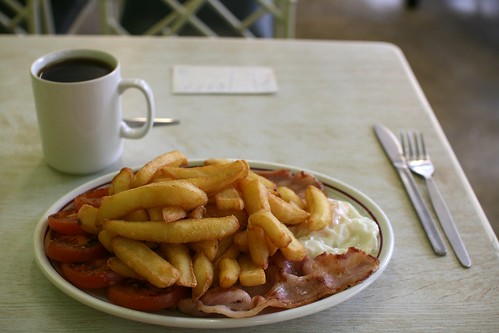 Spent one day in London for a project with a mobile phone carrier and a design agency. The project consisted in both a presentation and a workshop to make clients appropriate the insights I brought (through a set of exercises/break-out groups). It was kind of painful to each LHR because my Easyjet flight has been cancelled and I had to take BA, which was on strike.
Spent one day in London for a project with a mobile phone carrier and a design agency. The project consisted in both a presentation and a workshop to make clients appropriate the insights I brought (through a set of exercises/break-out groups). It was kind of painful to each LHR because my Easyjet flight has been cancelled and I had to take BA, which was on strike.
In parallel, Fabien, Laurent and I completed another project about networked objects and home appliances for a client with the help of Etienne from XPteam. I still have to finalize the exec summary of the report and send it tomorrow to the client.
 Finally, it was my last week of teaching for the semester at HEAD-Geneva. These two sessions about evaluating design products were the conclusion of my "Field research and interaction design" course. Students now have to work on their assignments: a field study that will lead to the description of design implications (storyboards, scenarios, paper prototypes, specifications, etc.) I am definitely curious about the results and now need to write a review of the year course to see what we can change or improve for next year. And yes the picture above shows the place where courses are given, an old and curious building in Geneva.
Finally, it was my last week of teaching for the semester at HEAD-Geneva. These two sessions about evaluating design products were the conclusion of my "Field research and interaction design" course. Students now have to work on their assignments: a field study that will lead to the description of design implications (storyboards, scenarios, paper prototypes, specifications, etc.) I am definitely curious about the results and now need to write a review of the year course to see what we can change or improve for next year. And yes the picture above shows the place where courses are given, an old and curious building in Geneva.
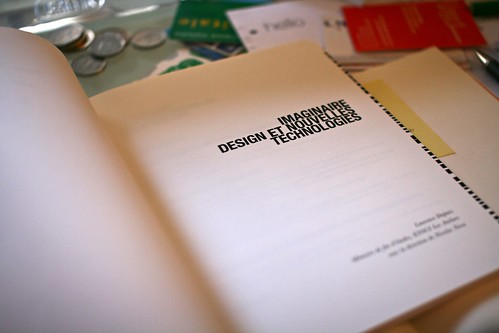
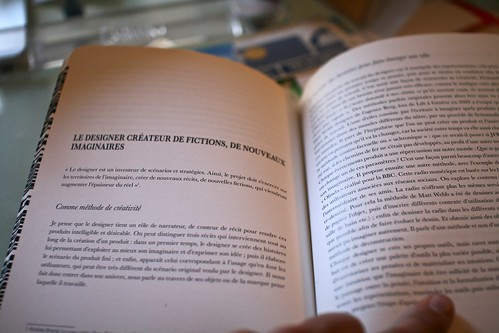 Besides, I received my (physical) copy of Laurence Dupuis' dissertation (under my supervision, at ENSCI in Paris) about Imagination, design and digital technologies. It's full of interesting insights and discussion with people such as Jean-Louis Fréchin, Frederic Kaplan or Bruce Sterling. Only in French though.
Besides, I received my (physical) copy of Laurence Dupuis' dissertation (under my supervision, at ENSCI in Paris) about Imagination, design and digital technologies. It's full of interesting insights and discussion with people such as Jean-Louis Fréchin, Frederic Kaplan or Bruce Sterling. Only in French though.
More and more complex pedometer games
 Pedometers connected to video-games are more and more complex, as attested by this Pokéwalker, a Poké Ball-shaped pedometer which can connect to Pokémon HeartGold and SoulSilver game cards via infrared signals. See the possibilities:
Pedometers connected to video-games are more and more complex, as attested by this Pokéwalker, a Poké Ball-shaped pedometer which can connect to Pokémon HeartGold and SoulSilver game cards via infrared signals. See the possibilities:
"It uses a currency known as "watts", which are obtained as the player walks with the device. Every 20 steps will earn the player one watt. It can communicate with other Pokéwalkers. Exchanges are not limited merely to watts, but also items and Pokémon
When players transfer a Pokémon from their game into their Pokéwalker, they can select which route they would like to take their Pokémon along. Depending on which route the player takes (such as in a grassland or by the sea), they will encounter different wild Pokémon and items. When players first begin their journeys with the Pokéwalker, the list of routes they can select from is short. But, the more players take a stroll with their Pokémon, the more routes will appear and the more Pokémon and items they will be able to get.

And you can get a more in-depth perspective in Katie Salen's article Pokéwalkers, Mafia Dons, and Football Fans: Play Mobile with Me. Why do I blog this? documenting material about tracking technologies and how game mechanics could lead to peculiar usage of such platforms.
Les Editions Volumiques, Paper computing and curious reading interactions
 Les Editions Volumiques finally launched their website showing plenty of curious and original products based on mixing paper and digital technologies:
Les Editions Volumiques finally launched their website showing plenty of curious and original products based on mixing paper and digital technologies:
"Here are the first pieces of les évolutions dynamiques following research on both volume and interactivity, playfully mixing paper and computation. By allowing interactivity and gameplay in the page (for example with the Duckette project) or between the pages (in The book that turns its own pages, or Labyrinthe), we try to bring new life to paper. We then pushed physical behavior to paper and ink (the book that disapears). There, the paper is no longer only the frame for representation, but at the same time the field of a real physical experience. We also played with the volume and perspective of book and content (paradoxales, Meeting-Zombies). And then, we tried to combine paper with this little computer-object almost of us all carry everywhere: our cell phone (the night of the living dead pixels, (i) pirates)."
Why do I blog this? I find these projects fascinating and love the idea of mixing digital tech with paper to create compelling user experiences. The examples showed on the picture (see more on their website) are stunning and show the future of books go far beyond boring reading machines. The use of playful metaphors and game mechanics in the work of Bertrand and Etienne are also highly intriguing for those interested in inspiring ways to renew the reading experience.
Besides, if you're interested in this type of "paper computing", be sure to check the Papercomp 2010 workshop at Ubicomp. Organized by friends from EPFL, it's based on similar ideas:
"Paper is not dead. Books, magazines and other printed materials can now be connected to the digital world, enriched with additional content and even transformed into interactive interfaces. Conversely, some of the screen-based interfaces we currently use to interact with digital data could benefit from being paper-based or make use of specially designed material as light and flexible as paper. In a near future, printed documents could become new ubiquitous interfaces for our everyday interactions with digital information. This is the dawn of paper computing. "
Verbs and design and verbs
Looking at interaction design metaphors lately, I've been reading Chris Crawford's "The Art of Interactive Design: A Euphonious and Illuminating Guide to Building Successful Software". As mentioned in this other blogpost, I like his approach that uses verbs: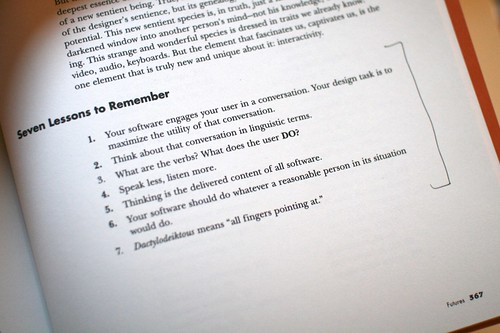
Using linguistics as a metaphor for HCI/interaction design is of coruse very old and other people than Crawford proposed similar approaches. However, the idea of focusing on verbs (what people can do) in design is interesting and used here and there. See for example the recommendation #2 in Jyri Engeström's slides about designing social software ("define your verbs").
As appealing as it is, I found an interesting quote in Howard Becker's book "Telling About Society" that (IMHO) explain my interest in verbs:
"it's a confusing error to focus on nouns rather than verbs, on the objects rather than the activities, as though we were investigating tables or charts or ethnographies or movies. It makes more sense to see artifact as the frozen remains of collective action, brought to life whenever someones uses them - as people's making and reading charts or prose, making and seeing films. We should understand the expression a film as shorthand for the activity of 'making a film' or 'seeing a film'."
(Thanks Basile for pointing this out)
Why do I blog this? Material for my interaction design course about user observations and design. This notion of verbs is interesting given its 2-facets: you can design something by using the verb metaphor (you then define verbs that set what people can do) and study how people employs the designed artifacts by studying what they do (which is defined by the verb). The action, defined by the verb, is more important than the artifact (defined as a noun) itself.
Last week, recent encounters
[Short note: blogging is more and more difficult with travels, consulting gigs and the need to spend some time offline, i will try to post some form of weeknotes with a visual and short text twist. It's not very fancy, only curious stuff I've stumbled across and collected last week. Of course I'll post more meat if I have time.]
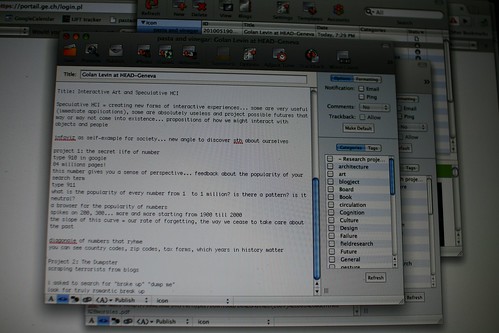
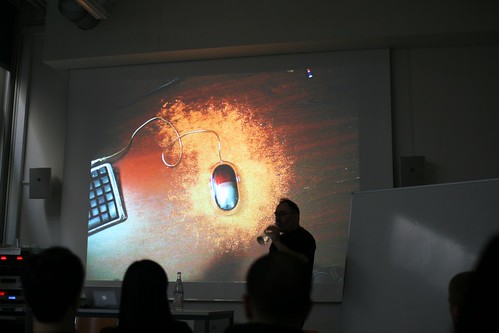
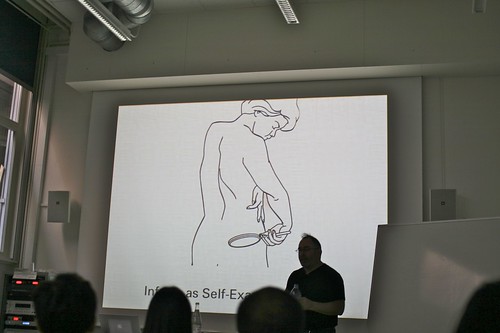 An intriguing speech by Golan Levin at HEAD-Geneva (Geneva University of Art and Design) about interactive art and speculative HCI. Levin described some of his projects and framed them as "creating new forms of interactive experiences... some are very useful (immediate applications), some are absolutely useless and project possible futures that may or may not come into existence... propositions of how we might interact with objects and people". I liked the idea of "infoviz as self-examination for society" and his thoughts about the computer mouse: "a mouse is pathological, as one of my teacher told me: to interact with a computer is to have a computer that has a model of you as one finger", "a urinal knows more about me than a computer mouse"
An intriguing speech by Golan Levin at HEAD-Geneva (Geneva University of Art and Design) about interactive art and speculative HCI. Levin described some of his projects and framed them as "creating new forms of interactive experiences... some are very useful (immediate applications), some are absolutely useless and project possible futures that may or may not come into existence... propositions of how we might interact with objects and people". I liked the idea of "infoviz as self-examination for society" and his thoughts about the computer mouse: "a mouse is pathological, as one of my teacher told me: to interact with a computer is to have a computer that has a model of you as one finger", "a urinal knows more about me than a computer mouse"
 Some visual research about the gamepad project, like this beautiful representation of what was needed in 1958 to play "Tennis for Two" on an oscilloscope [via].
Some visual research about the gamepad project, like this beautiful representation of what was needed in 1958 to play "Tennis for Two" on an oscilloscope [via].
 Preparing a speech about Science-Fiction and urban environments, I've been drawn to various representations of cities in the context of speculative movies. This picture of "Conquest of the Planet of the Apes" (1972) was of interest... as it shows how an existing US university (UC Irvine) was used as a scene for this movie.
Preparing a speech about Science-Fiction and urban environments, I've been drawn to various representations of cities in the context of speculative movies. This picture of "Conquest of the Planet of the Apes" (1972) was of interest... as it shows how an existing US university (UC Irvine) was used as a scene for this movie.
 WiFi Camera is a curious project that " takes "pictures" of spaces illuminated by wifi in much the same way that a traditional camera takes pictures of spaces illuminated by visible light".
WiFi Camera is a curious project that " takes "pictures" of spaces illuminated by wifi in much the same way that a traditional camera takes pictures of spaces illuminated by visible light".

 Two visualizations by Barbara Hahn and Christine Zimmermann that caught my attention. It's a project called "Visual Atlas of Everyday Life at the Hospital" that represents selected organizational and communicative sub-processes within the patient process at Berne University Hospital. Some of the them are related with waiting times, others are about patient recovery and leaving the hospital. The fact that an hospital could used these data in this form is interesting. I've put this in perspective with Fabien's recent work about representing Geneva based on people's usage of Flickr and Foursquare:
Two visualizations by Barbara Hahn and Christine Zimmermann that caught my attention. It's a project called "Visual Atlas of Everyday Life at the Hospital" that represents selected organizational and communicative sub-processes within the patient process at Berne University Hospital. Some of the them are related with waiting times, others are about patient recovery and leaving the hospital. The fact that an hospital could used these data in this form is interesting. I've put this in perspective with Fabien's recent work about representing Geneva based on people's usage of Flickr and Foursquare:
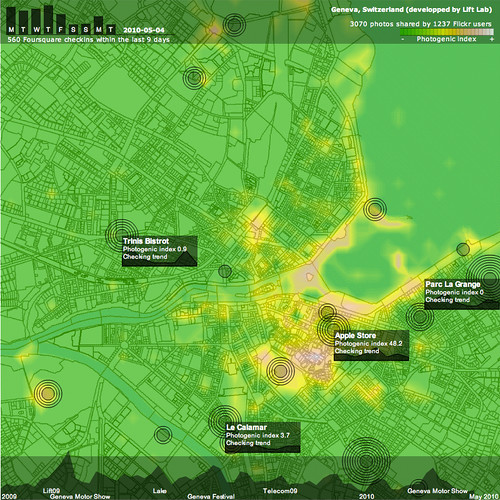
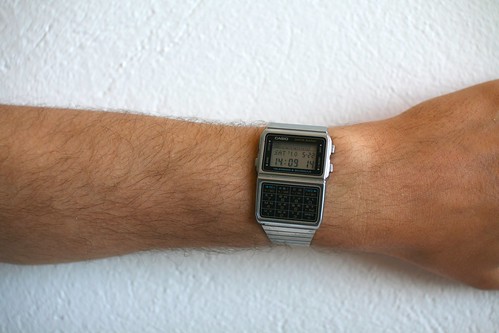 This 8-digit calculator watch by Casio triggered some inspiring discussion about object convergence, an interesting follow-up to my post about the pianococktail. It left me wondering about a watch connected to the Internets. For some reasons, I haven't seen groundbreaking project along these lines. It's not that I want to connect anything to the réseau des réseaux but I am curious about interconnected time machines.
This 8-digit calculator watch by Casio triggered some inspiring discussion about object convergence, an interesting follow-up to my post about the pianococktail. It left me wondering about a watch connected to the Internets. For some reasons, I haven't seen groundbreaking project along these lines. It's not that I want to connect anything to the réseau des réseaux but I am curious about interconnected time machines.
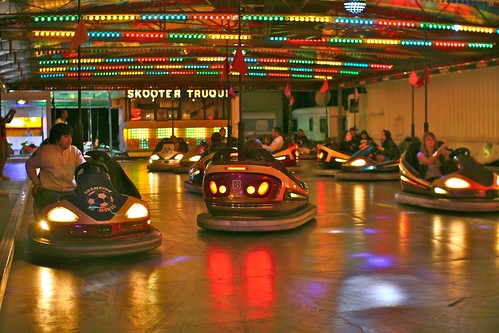
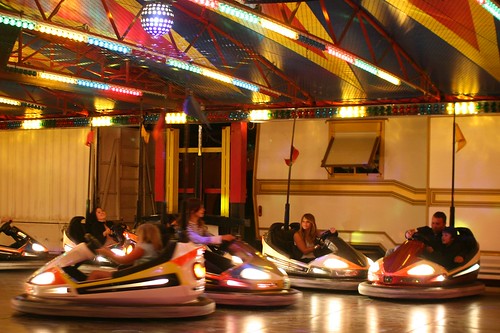 A trip to the funfair is always inspiring for informal observations of various forms of play. More specifically, bumper cars ("dodgems" in the UK, "auto-tamponneuses in France) were very interesting to observe driving behavior of people ready to bump into each other. What happens here? Why do people seem so happy doing this? Could it be an interesting metaphor for new car interfaces? I don't have the answer but I definitely have a gut feeling that bumper cars are an interesting answer to some problems (which remains to be found). Next step is to dig the scientific literature about this funfair device.
A trip to the funfair is always inspiring for informal observations of various forms of play. More specifically, bumper cars ("dodgems" in the UK, "auto-tamponneuses in France) were very interesting to observe driving behavior of people ready to bump into each other. What happens here? Why do people seem so happy doing this? Could it be an interesting metaphor for new car interfaces? I don't have the answer but I definitely have a gut feeling that bumper cars are an interesting answer to some problems (which remains to be found). Next step is to dig the scientific literature about this funfair device.
Actor-Network Theory and design
 The paper "Making the Social Hold: Towards an Actor-Network Theory of Design" by Albena Yaneva is an interesting contribution to the role of Actor-Network Theory in design.
The paper "Making the Social Hold: Towards an Actor-Network Theory of Design" by Albena Yaneva is an interesting contribution to the role of Actor-Network Theory in design.
It basically shows how various ANT concepts can be relevant and insightful in the context of designing artifacts. Relying on notions such as scripts or delegation of action to objects the author examines various mundane artifacts (stairs, handrails, elevator buttons, etc.) and show how the way they have been designed triggers "specific ways of enacting the social".
Some excerpts I found interesting:
"If you follow me for a moment, again, in my trajectory, you will witness how the objects from my university mornings (my key, the door lock of the resource room, the elevator buttons, the staircase handle, the conference room arrangement) do not stand for social forces and divisions, nor do they symbolically represent the university’s order, hierarchy or divisions of labor; rather, they perform the social as we use them, and connect us in a new way with fellow colleagues, students and university administrators. (...) expanding the project of ANT to the field of design requires mobilizing this method’s persistent ambition to account and understand (not to replace) the objects of design, its institutions and different cultures. This means we must understand the designerliness of design objects, networks and artifacts, instead of trying to provide, by all means, a stand-in (social, psychological, historical or other) explanation of design, i.e. a psychological explanation of the creative energies of the inventor, a psychoanalytical explanation of the client–designer–user relationship, a historical explanation of the social contexts of design. (...) An ANT approach to design would consist in investigating the culture and the practices of designers rather than their theories and their ideologies, i.e. to follow what designers and users do in their daily and routine actions. (...) we should study the experiences of both users and designers, as well as the numerous connections that this research would reveal."
Why do I blog this? collecting material about ANT and design, a hot topic lately. What I find interesting here is that there the move from sociology to design is similar to the one we have seen in the 80s from psychology. At the time, cognitive psychology moved from explaining individual behavior by internal factors (the brain, a cognitive system bound to the individual) to explaining it with external factors (artifacts in our environment, the importance of context, the situated character of action). This led to the emergence of Situated Action or Distributed cognition. Conversely, sociology moves from the "social" to artifacts (non-humans) and show how social is inscribed in objects.
Another important point of this article is the proposition that Yaneva makes as a research agenda: instead of investigating the influence of external factors (be they economical, cultural, political) on design, the idea is to describe the design process itself by capturing "the movements of artifacts and designers in the design studio".
Yaneva, A. (2009). Making the Social Hold: Towards an Actor-Network Theory of Design. Design and Culture, Volume 1, Number 3, November 2009
Pianococktail and the convergence of artifacts
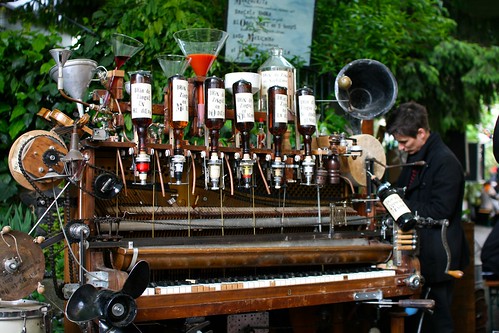 An intriguing encounter this afternoon with a pianococktail, i.e. a piano that mixes drinks based on the combination of keys played. Being a reader of Boris Vian, running across this crazy object he described in his novel “L’ecume des Jours” ("Froth on the Daydream") is always a pleasure. The one I saw this afternoon has been designed by Géraldine and Nicolas Schenkel in Geneva.
An intriguing encounter this afternoon with a pianococktail, i.e. a piano that mixes drinks based on the combination of keys played. Being a reader of Boris Vian, running across this crazy object he described in his novel “L’ecume des Jours” ("Froth on the Daydream") is always a pleasure. The one I saw this afternoon has been designed by Géraldine and Nicolas Schenkel in Geneva.
Here's how Vian explains how the device works:
"For each note there’s a corresponding drink – either a wine, spirit, liqueur or fruit juice. The loud pedal puts in egg flip and the soft pedal adds ice. For soda you play a cadenza in F sharp. The quantities depend on how long a note is held – you get the sixteenth of a measure for a hemidemisemiquaver; a whole measure for a black note; and four measures for a semibreve. When you play a slow tune, then tone comes into control to prevent the amounts growing too large and the drink getting too big for a cocktail – but the alcoholic content remains unchanged. And, depending on the length of the tune, you can, if you like, vary the measures used, reducing them, say, to a hundredth in order to get a drink taking advantage of all the harmonics, by means of an adjustment on the side."
Why do I blog this? sunday encounter with a curious object that corresponds to the absurd convergence of two very different artifacts. The idea of mixing distinct functions in one object is an interesting innovation process but it's sometimes more poetic and intriguing to do it with very distant class of objects.
As a general exercise to envision alternative near future worlds, it would be good to think about similar convergence between very remote objects. Making two functions converge is a difficult purpose. This example reminds me of a talk by Ben Fullerton at interaction 2010 in which he described a project he worked on at IDEO forBang&Olufsen: a music player that was also a phone, as opposed to a a phone that would also be a music player. This kind of approach is inspring IMHO as it forces to rethink the role of the two objects in very different ways.
Phone surface
"Research" in Design
Lift10 is over and I finally found some time to work on my stack of books. Which lead me to this book that Lysianne gave me during the conference: Recherche-création en design. Modèles pour une pratique expérimentale. This book (only in French) is the final milestone in a swiss research project called "CreaSearch" that I discussed a while back. For English readers, some of the material covered in this book can also be found in "Creasearch - Methodologies and Models for Creation-based Research Projects in Design" (from the proceedings of the Swiss Design Network Symposium 2008) by Magdalena Gerber, Lysianne Léchot Hirt, Florence Marguerat, Manon Mello and Laurent Soldini.
The aim of this project is to discuss the different forms of "research" in arts and design practices out of commercial spheres: What's doing research when you are a designer working in an academic institution? How does (academic) designers' activities compare to researchers practices? Can research in the field of design go beyond new product development or sociological/aesthetic studies of designed artifacts? Is there a common thread between all the activities based on creating objects? Fueled by the current debate about doing research in arts and design schools, the questions addressed in the book echoes a lot with my current interest in design research.
In this research project, the authors defines the notion of "creation-research": "research activities, in design and in art, which incorporate the creation process (or the conception process) in a research process". They than maps how it is understood and practised in design/arts communities and to what extent it provides a pragmatic context for developing research models that are methodologically acceptable for designers focused on a creative activity and for the international design research community. As such, it sets off to propose an epistemology of design research by showing the specificity of the knowledge it can produce.
Exemplified by case studies, this proposition revolves around a methodological model for research creation projects in design that is copiously described in the project deliverables and the book. See for yourself:

Why do I blog this? This is an interesting framing to engage (or continue) the discussion about what is research in the field of design. I liked the way the authors did not fetishize too much the idea of a framework. The elements that are defined in the model above can be seen as heuristics, instead of a prescribed step-by-step process.
It's also interesting to compare the discussion about "research in design" with the current debate about "design research" and its role in new product development. The two are very distinct and emerges out of different constraints.
A definition of transduction
An interesting quote that will certainly frame our current work on the gamepad project:
"the term [transduction] denotes a process – be it physical, biological, mental or social – in which an activity gradually sets itself in motion, propagating within a given area, by basing this propagation on a structuration carried out in different zones of the domain: each region of the constituted structure serves as a constituting principle for the following one, so much so that a modification progressively extends itself at the same time as this structuring operation. (...) The transductive operation is an individuation in progress; it can physically occur most simply in the form of progressive iteration"
From: Simondon, G. (1964/1992) ‘The genesis of the individual’, in J. Crary and S. Kwinter (eds.) Incorporations. New York: Zone Books.
Why do I blog this? This quote struck me as highly useful to frame the evolution of joypads in the game controller project. Will certainly include it in the theoretical framing of the study as it enable to describe how different objets evolves through iterations with "constituting principles".
An old phone booth
Yes, phones are mobile and everywhere now. But before that, public phone used to sit inside a booth... and before that they were also out of the booth. People would take the phone and put your head inside this kind of device encountered at CERN the other day (te gent on the picture is Mr. Woebken).

Why do I blog this I wonder when this sort of protection will be re-installed in cities. A a sort of place where it's convenient (and acceptable) to make a phone call. It reminds me of the use of cell-phones in public phone booth.
Location-awareness sharing and affordances in the subway
Two recent articles about location-based platforms caught my eyes Seeburger, J., & Schroeter, R. (2009, Nov 23-27). Disposable Maps: Ad hoc Location Sharing. In J. Kjeldskov, J. Paay & S. Viller (Eds.), Proceedings OZCHI 2009 (pp. 377-380). Melbourne, VIC: The University of Melbourne.
"The gathering of people in everyday life is intertwined with travelling to negotiated locations. As a result, mobile phones are often used to rearrange meetings when one or more participants are late or cannot make it on time. Our research is based on the hypothesis that the provision of location data can enhance the experience of people who are meeting each other in different locations. This paper presents work-in-progress on a novel approach to share one’s location data in real-time which is visualised on a web-based map in a privacy conscious way. Disposable Maps allows users to select contacts from their phone’s address book who then receive up-to-date location data. The utilisation of peer-to-peer notifications and the application of unique URLs for location storage and presentation enable location sharing whilst ensuring users’ location privacy. In contrast to other location sharing services like Google Latitude, Disposable Maps enables ad hoc location sharing to actively selected location receivers for a fixed period of time in a specific given situation. We present first insights from an initial application user test and show future work on the approach of disposable information allocation."
(Thanks Antonio!)

Belloni, Nicolas and Holmquist, Lars Erik and Tholander, Jakob (2009)See you on the subway: exploring mobile social software. In: In Proceedings of the 27th international Conference Extended Abstracts on Human Factors in Computing Systems, 4-9 April 2009, Boston, USA.
"This project explores the social possibilities of mobile technology in transitional spaces such as public transport. Based on a cultural probes study of Stockholm subway commuters, we designed a location- based friend finder that displays only people in the same train as the user. (...) The interviews showed that the users did not always have an obvious idea for what actions to take once they realized that a friend was on the same train (...) This points to the complexity a social situation like this and the multitude of social layers that comes into play for designers of social services. In this case, it seems like the user didn‟t feel close enough to his work colleague for taking contact at this particular moment. (...) Adding the possibility to call the person or send a text message could be one of functionalities improving the user experience."
Why do I blog this? Collecting material for current projects about location-based services. Both papers describe relevant studies about the user experience of location-awareness and the complexity of building social applications on top of it.
Cern input interfaces
A bunch of curious input interfaces I encountered at CERN today. Interesting diversity: lots of specific affordances, several distinct constraints that lead to a wide variety of possibilities.
They control information and fluid through mechanical, electric, electromechanical and electronic mechanisms. Some are shiny and colorful, others are dirty and old.
And yes, we've had our fifth Lift conference!
Wifi sharing request
 An interesting encounter last week in Lyon: a message stuck on a door from a person who want to share a wifi connection. The translation in English goes like:
An interesting encounter last week in Lyon: a message stuck on a door from a person who want to share a wifi connection. The translation in English goes like:
"Hello, I would like to share a Wi-Fi connection with someone. I need the internet for my studies (till June) but I do not want a subscription for 3 months. Anyone interested? You can leave me a note in my mailbox or come see me on the 4th floor. Thanks."
Why do I blog this? An interesting example of how a technology (and also the business model of such technology) foster foster social interaction and forms of communication about it.
In addition, it's also curious to see what sorts of infrastructure are shared (or willing to be shared). While it seems socially acceptable to share wifi (or to ask for it), what would be the situation if someone asked for water, gas or electricity?
Recap of Lift seminar @ Imaginove
Yesterday evening, I co-organized a Lift seminar in Lyon, in partnership with Imaginove, a cluster of digital content companies. Located in a an old flour mill, the seminar was about new forms of video game play with a specific focus on Transmedia and Location-Based Games.
To deal with this, I invited two bright contributors: David Calvo who is Creative Director from French video game studio Ankama (as well as a fine writer, comic-book author) and Mathieu Castelli from C4M, who was also the founder of Newt Games, the now defunct company which was a pioneer in location-based games in Japan.
David started with a presentation in which he descried in personal vision of what the "Transmedia" domain consists in. He basically debunked the fuss around this term by showing how this term is now used as a buzzword. According to him, adopting a "transmedia" perspective corresponds to the following approach:
- Building a "world model" with its own background and constraints (because design emerges out of constraints)
- Nurture this world model by elements coming from users, but not in an explicit "user-generated content way" in which you would ask people to contribute: it's rather about having ears on the ground and observing Anakama players in game conventions, looking at forums, comments on websites, the way people name objects and gods in the game, etc....
- Instantiate these insights into characters, book chapters, magazine articles, game mechanics, background changes...
In sum, it's a sort of implicit user-generated content harvesting that can be turned into game material for Dofus or Wakfu (and all the books, manga, magazines and on-line platforms about them).
In the second presentation, Mathieu told us the story of Mogi, a mobile service in which which the game play somehow evolves and progresses via a player's location. Developed 7 years ago for the japanese market by a French company, Mogi was one the few commercial products that reach the market. Mathieu highlighted the difficult evolution of such games and recapped some issues they encountered such as: the fairly low number of phone with GPS (at the time and now), the difficulty to test game mechanics (because you need to go on the field), the need to have a critical mass of players, etc. which are very close to what I described in my book about locative media.
Mathieu concluded his presentation by showing Playground, a new initiative that aims at providing LBS designers with a point and click platforms to implement and test their own games. This "playground" system would be tool set for the creation of what they can "Real World games" and grow the community of developers.


